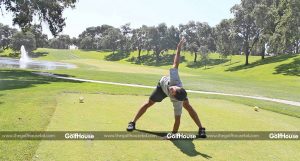The game of golf stresses many different parts of your body. And, if you are not preparing your body to deal with these stresses, you leave yourself susceptible to pain, and injury, from overuse caused by the repetitive motions of golf. As we age our muscles tend to lose flexibility, strength, and resilience.
To maintain, or develop, the fitness level needed to play golf, I recommend a cross training program. No, not running, swimming and weight lifting, but a program that uses disciplines like yoga and Pilates to improve your strength and mobility. Athletes like Lebron James, Tiger Woods and Morgan Pressel have already discovered the value of these disciplines, and I am sure you would benefit from these programs as well.
Below is a sample cross training program that I use with my golfer class. You should at least consider alternating between Yoga and Pilates classes to get most of the benefit.
The Warm Up:
Begin every session with a set of exercises that properly warms up the entire body, using movements that warm the muscles and gets the synovial fluid moving to lubricate and loosen the joints.
Movements taken from Yoga and Tai chi are excellent for getting the body moving and into a warm and relaxed state prior to the workout. Shoulders, knees, ankles, wrists, spine and hips are all areas golfers use regularly. I like to do fluid rhythmic movements for all warm ups. Here are a few warm up examples.

Strengthen:
Strengthen the various muscles groups, and especially the core muscles, by using movements taken from yoga. Yoga helps to build strength, particularly in the core and stabilizer muscles, with twists and balance postures that build strength and muscle control. Doing these types of poses uses muscles that are often neglected in other forms of training. Stronger stabilizer muscles mean better posture and alignment, and strengthening of these muscles will result in much better performance on the golf course.
A few examples of yoga poses for building core strength, and overall strength, are plank, side plank modification with one leg lifted, airplane with one hand on the block, modified triangle, revolved triangle and modified extended side angle. These postures incorporate the internal and external obliques and transverse abdominis, as well as many other primary and secondary muscle groups.
Stretch:
I am a big believer in the benefits of improved flexibility, and often remind to all that it is never about what you are doing today, it is about what you will accomplish with time and practice. I always include a total body stretch. The stretching segment includes hamstrings, shoulders, back, gluts, and piriformis, oblique’s, calf’s and quadriceps. A good example of some of these stretching postures, taken from yoga, would be downward facing dog, pigeon, knot posture and child’s pose. I like to incorporate Pilate’s on the ball stretches, such as hip openers, and back stretches to decompress the spine.

Release:
The foam roller is a key component of cross training. It is very important and beneficial to release the fascia around the muscles. You can utilize a foam roller before or after workouts.
The self-massage of a foam roller will literally “release” muscle tissue and encourage mobility. Although it can be painful at times, it is highly beneficial. The best roller to use is a softer type of foam roller. The most obvious benefit of using a foam roller is to prevent injury due to repetitive forms of exercise and inadequate stretching. I always incorporate the foam roller at the end of the stretching segment.
This type of program will, in a short period of time, have you feeling better and moving better. Overall health and wellness is the integration of many things. Becoming more fit and gaining mobility is also the integration of many things. Cross training is where it’s at, plain and simple! To get into top shape, and be at your personal best, requires strength, flexibility, cardiovascular fitness and, let’s not forget, releasing of the fascia.
Remember, it’s not about what you can do today, it is about the long term goal of feeling better and moving better, which in turn leads to better performance on the course and off.















